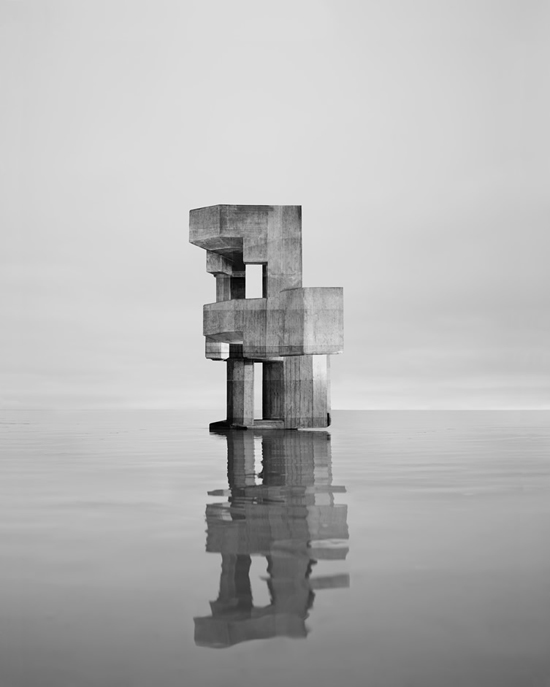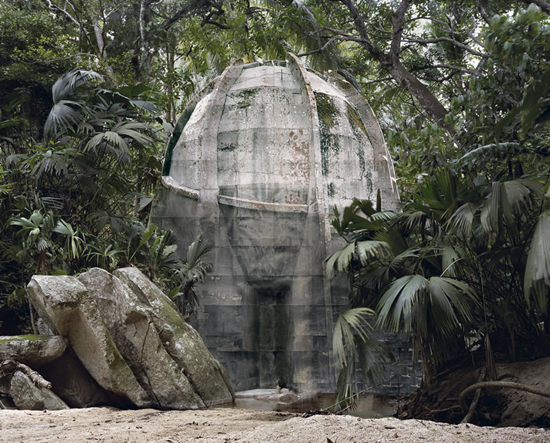| SIMON DENISON IMAGE & TEXT |
| PREVIOUS | NEXT |
NOÉMIE GOUDAL: THE GEOMETRICAL DETERMINATION OF THE SUNRISE New Art Gallery, Walsall
The Geometrical Determination of the Sunrise is a complex, enigmatic show which brings together a diverse range of new works – framed images, installations, films – by the young French artist Noémie Goudal who graduated from the RCA in 2010. Goudal’s previous exhibitions, Les Amants and Haven Her Body Was consisted largely of constructed, imaginary landscapes, involving either trompe-l’oeuil sculptures photographed in a natural setting (a waterfall made out of bed sheets, an iceberg made from polystyrene) or illusionary montages of different locations (a concrete basement opening onto a tropical island). The new show restates Goudal’s interest in photographic illusion. The installation Ciels, a giant combination print filling an entire wall of the gallery, presents a concrete interior which appears to have been flooded by a tropical sea. Study on Perspective I is a photograph of another modernist interior, sliced into four pieces, each receding in terms of photographic perspective, printed on four perspex panels set one behind the other, providing a sculptural embodiment of stereographic illusion. Meanwhile in Stereoscopes four stereoscopic viewers, showing stereo images of coastal buildings and natural features, remind us of the longevity of our cultural longing to transfigure photographs back into the three-dimensional spaces they depict. The two main series of framed images in this show, Observatoires and Satellites, represent what appear to be individual buildings of uncertain but possibly religious or ritual function, isolated in landscape settings. The ‘buildings’, however, are in fact photographs of modernist concrete structures (such as sound mirrors), or digitally cropped parts of buildings (such as concrete stairways) pasted onto a structural support and rephotographed in a new setting – flat, open arenas such as the edge of the sea, or a stretch of sand or grass (Observatoires), or set in the South American jungle (Satellites). At first glance the pictures seem to have indexical photographic integrity but a closer look reveals the artifice: the gaps between the sections of the flat photographic structures have been left clearly visible. From a psychological point of view, these works play a strange, teasing game with the viewer. The near life-size Study on Perspective I seems to promise but simultaneously frustrate our entry into a real three-dimensional space. Walking round to the back of the installation, we find that the building interior was photographed from the opposite direction as well, and that this second view is printed on the reverse of each panel, sliced in the same way. Here, however, the perspective is reversed, with the more distant parts of the interior brought nearer to view, shattering the illusion of perspective in what seems like a mockery of our earlier credulity. Similarly Observatoires and Satellites beckon us seductively from a distance with their formal elegance, and sublime intimations of infinite space and clarity. Willingly letting ourselves be immersed in representational space, we wonder what manner of natural or man-made disaster might have led to the abandonment of these fragments of some half-recognised civilisation. But step closer, spot the illusion, and the suspension of disbelief is undermined. These artworks refuse our advances; they wink, then slap us in the face. Curiously, their enticing but resistant qualities are amplified by the gallery setting, the large pristine exhibition hall on the 3rd Floor of the New Art Gallery offering nowhere to sit, even to watch the films, except for two tiny windowsills at opposite ends of the space. One would like to stay and gaze, but the space makes no concessions. During my visit, most other visitors seemed to hurry through before getting away. So how do I read these works? Most obviously they speak of the untrustworthy nature of photographic representation, that ubiquitous trope of postmodern art practice. (As if we still have to be told!) However the explicit artifice and the push-pull qualities of the images suggest something more. The title of the show and of the two series Observatoires and Satellites frame the work in terms of our age-old quest for knowledge (both of what is beyond us, and of ourselves) based on observable information. Photography, of course, is our primary medium of visual data and these intriguing pictures therefore perhaps seem to say: you know that all this is not true, and yet you still wish to believe? Rather than merely comment on the nature of photography, they challenge us teasingly, probing the tenacity of our faith in all forms of knowledge and myth – photographic, political, religious, cultural and romantic, among others. The two films sit at a tangent to the other works in the show because although they stage little dramas, they do not deal so evidently with illusion. Diver focuses on a high diving board set in a mountain lake. Six divers climb up a ladder to the high board, dive off, and repeat. Tanker shows us the cavernous interior of a large ocean-going tanker. White-overalled crew members climb down a long ladder from a hatch in the roof before disappearing below floor level, until one finally decides to climb back up again to the top, and then the whole sequence starts again. In both films, the ‘actors’ often appear hesitant, as if unsure whether they are climbing or descending at the required, even speed. In Tanker, light streams into the interior from the hatch, recalling the photography of cathedrals. Both films remind us that our natural aspiration is to go up in search of transcendent experience, just as in an observatory we climb and look up to seek knowledge. The tragi-comical bathos of both films, however, suggests perhaps that in present conditions neither aspiration is likely to be realised. |
 |
|---|---|
 |
|